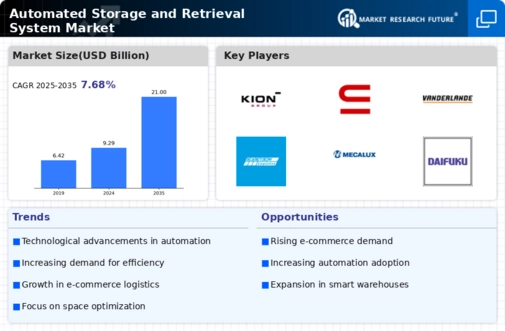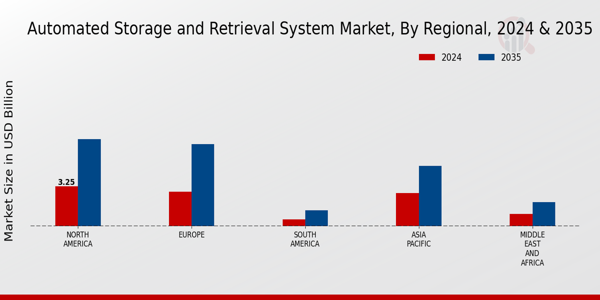Load Based ASRS
Shuttle And Bot-Based ASRS
Carousel Based
Vertical Lift Module (VLM) ASRS
Automotive
Metals And Machinery
Food And Beverages
Chemicals
Healthcare
Semiconductor And Electronics
Retail And E-Commerce
Aviation
Others
North America
Europe
South America
Asia Pacific
Middle East and Africa
North America Outlook (USD Billion, 2019-2035)
North America Automated Storage and Retrieval System Market by Type
Load Based ASRS
Shuttle And Bot-Based ASRS
Carousel Based
Vertical Lift Module (VLM) ASRS
North America Automated Storage and Retrieval System Market by Industry Vertical Type
Automotive
Metals And Machinery
Food And Beverages
Chemicals
Healthcare
Semiconductor And Electronics
Retail And E-Commerce
Aviation
Others
North America Automated Storage and Retrieval System Market by Regional Type
US
Canada
US Outlook (USD Billion, 2019-2035)
US Automated Storage and Retrieval System Market by Type
Load Based ASRS
Shuttle And Bot-Based ASRS
Carousel Based
Vertical Lift Module (VLM) ASRS
US Automated Storage and Retrieval System Market by Industry Vertical Type
Automotive
Metals And Machinery
Food And Beverages
Chemicals
Healthcare
Semiconductor And Electronics
Retail And E-Commerce
Aviation
Others
CANADA Outlook (USD Billion, 2019-2035)
CANADA Automated Storage and Retrieval System Market by Type
Load Based ASRS
Shuttle And Bot-Based ASRS
Carousel Based
Vertical Lift Module (VLM) ASRS
CANADA Automated Storage and Retrieval System Market by Industry Vertical Type
Automotive
Metals And Machinery
Food And Beverages
Chemicals
Healthcare
Semiconductor And Electronics
Retail And E-Commerce
Aviation
Others
Europe Outlook (USD Billion, 2019-2035)
Europe Automated Storage and Retrieval System Market by Type
Load Based ASRS
Shuttle And Bot-Based ASRS
Carousel Based
Vertical Lift Module (VLM) ASRS
Europe Automated Storage and Retrieval System Market by Industry Vertical Type
Automotive
Metals And Machinery
Food And Beverages
Chemicals
Healthcare
Semiconductor And Electronics
Retail And E-Commerce
Aviation
Others
Europe Automated Storage and Retrieval System Market by Regional Type
Germany
UK
France
Russia
Italy
Spain
Rest of Europe
GERMANY Outlook (USD Billion, 2019-2035)
GERMANY Automated Storage and Retrieval System Market by Type
Load Based ASRS
Shuttle And Bot-Based ASRS
Carousel Based
Vertical Lift Module (VLM) ASRS
GERMANY Automated Storage and Retrieval System Market by Industry Vertical Type
Automotive
Metals And Machinery
Food And Beverages
Chemicals
Healthcare
Semiconductor And Electronics
Retail And E-Commerce
Aviation
Others
UK Outlook (USD Billion, 2019-2035)
UK Automated Storage and Retrieval System Market by Type
Load Based ASRS
Shuttle And Bot-Based ASRS
Carousel Based
Vertical Lift Module (VLM) ASRS
UK Automated Storage and Retrieval System Market by Industry Vertical Type
Automotive
Metals And Machinery
Food And Beverages
Chemicals
Healthcare
Semiconductor And Electronics
Retail And E-Commerce
Aviation
Others
FRANCE Outlook (USD Billion, 2019-2035)
FRANCE Automated Storage and Retrieval System Market by Type
Load Based ASRS
Shuttle And Bot-Based ASRS
Carousel Based
Vertical Lift Module (VLM) ASRS
FRANCE Automated Storage and Retrieval System Market by Industry Vertical Type
Automotive
Metals And Machinery
Food And Beverages
Chemicals
Healthcare
Semiconductor And Electronics
Retail And E-Commerce
Aviation
Others
RUSSIA Outlook (USD Billion, 2019-2035)
RUSSIA Automated Storage and Retrieval System Market by Type
Load Based ASRS
Shuttle And Bot-Based ASRS
Carousel Based
Vertical Lift Module (VLM) ASRS
RUSSIA Automated Storage and Retrieval System Market by Industry Vertical Type
Automotive
Metals And Machinery
Food And Beverages
Chemicals
Healthcare
Semiconductor And Electronics
Retail And E-Commerce
Aviation
Others
ITALY Outlook (USD Billion, 2019-2035)
ITALY Automated Storage and Retrieval System Market by Type
Load Based ASRS
Shuttle And Bot-Based ASRS
Carousel Based
Vertical Lift Module (VLM) ASRS
ITALY Automated Storage and Retrieval System Market by Industry Vertical Type
Automotive
Metals And Machinery
Food And Beverages
Chemicals
Healthcare
Semiconductor And Electronics
Retail And E-Commerce
Aviation
Others
SPAIN Outlook (USD Billion, 2019-2035)
SPAIN Automated Storage and Retrieval System Market by Type
Load Based ASRS
Shuttle And Bot-Based ASRS
Carousel Based
Vertical Lift Module (VLM) ASRS
SPAIN Automated Storage and Retrieval System Market by Industry Vertical Type
Automotive
Metals And Machinery
Food And Beverages
Chemicals
Healthcare
Semiconductor And Electronics
Retail And E-Commerce
Aviation
Others
REST OF EUROPE Outlook (USD Billion, 2019-2035)
REST OF EUROPE Automated Storage and Retrieval System Market by Type
Load Based ASRS
Shuttle And Bot-Based ASRS
Carousel Based
Vertical Lift Module (VLM) ASRS
REST OF EUROPE Automated Storage and Retrieval System Market by Industry Vertical Type
Automotive
Metals And Machinery
Food And Beverages
Chemicals
Healthcare
Semiconductor And Electronics
Retail And E-Commerce
Aviation
Others
APAC Outlook (USD Billion, 2019-2035)
APAC Automated Storage and Retrieval System Market by Type
Load Based ASRS
Shuttle And Bot-Based ASRS
Carousel Based
Vertical Lift Module (VLM) ASRS
APAC Automated Storage and Retrieval System Market by Industry Vertical Type
Automotive
Metals And Machinery
Food And Beverages
Chemicals
Healthcare
Semiconductor And Electronics
Retail And E-Commerce
Aviation
Others
APAC Automated Storage and Retrieval System Market by Regional Type
China
India
Japan
South Korea
Malaysia
Thailand
Indonesia
Rest of APAC
CHINA Outlook (USD Billion, 2019-2035)
CHINA Automated Storage and Retrieval System Market by Type
Load Based ASRS
Shuttle And Bot-Based ASRS
Carousel Based
Vertical Lift Module (VLM) ASRS
CHINA Automated Storage and Retrieval System Market by Industry Vertical Type
Automotive
Metals And Machinery
Food And Beverages
Chemicals
Healthcare
Semiconductor And Electronics
Retail And E-Commerce
Aviation
Others
INDIA Outlook (USD Billion, 2019-2035)
INDIA Automated Storage and Retrieval System Market by Type
Load Based ASRS
Shuttle And Bot-Based ASRS
Carousel Based
Vertical Lift Module (VLM) ASRS
INDIA Automated Storage and Retrieval System Market by Industry Vertical Type
Automotive
Metals And Machinery
Food And Beverages
Chemicals
Healthcare
Semiconductor And Electronics
Retail And E-Commerce
Aviation
Others
JAPAN Outlook (USD Billion, 2019-2035)
JAPAN Automated Storage and Retrieval System Market by Type
Load Based ASRS
Shuttle And Bot-Based ASRS
Carousel Based
Vertical Lift Module (VLM) ASRS
JAPAN Automated Storage and Retrieval System Market by Industry Vertical Type
Automotive
Metals And Machinery
Food And Beverages
Chemicals
Healthcare
Semiconductor And Electronics
Retail And E-Commerce
Aviation
Others
SOUTH KOREA Outlook (USD Billion, 2019-2035)
SOUTH KOREA Automated Storage and Retrieval System Market by Type
Load Based ASRS
Shuttle And Bot-Based ASRS
Carousel Based
Vertical Lift Module (VLM) ASRS
SOUTH KOREA Automated Storage and Retrieval System Market by Industry Vertical Type
Automotive
Metals And Machinery
Food And Beverages
Chemicals
Healthcare
Semiconductor And Electronics
Retail And E-Commerce
Aviation
Others
MALAYSIA Outlook (USD Billion, 2019-2035)
MALAYSIA Automated Storage and Retrieval System Market by Type
Load Based ASRS
Shuttle And Bot-Based ASRS
Carousel Based
Vertical Lift Module (VLM) ASRS
MALAYSIA Automated Storage and Retrieval System Market by Industry Vertical Type
Automotive
Metals And Machinery
Food And Beverages
Chemicals
Healthcare
Semiconductor And Electronics
Retail And E-Commerce
Aviation
Others
THAILAND Outlook (USD Billion, 2019-2035)
THAILAND Automated Storage and Retrieval System Market by Type
Load Based ASRS
Shuttle And Bot-Based ASRS
Carousel Based
Vertical Lift Module (VLM) ASRS
THAILAND Automated Storage and Retrieval System Market by Industry Vertical Type
Automotive
Metals And Machinery
Food And Beverages
Chemicals
Healthcare
Semiconductor And Electronics
Retail And E-Commerce
Aviation
Others
INDONESIA Outlook (USD Billion, 2019-2035)
INDONESIA Automated Storage and Retrieval System Market by Type
Load Based ASRS
Shuttle And Bot-Based ASRS
Carousel Based
Vertical Lift Module (VLM) ASRS
INDONESIA Automated Storage and Retrieval System Market by Industry Vertical Type
Automotive
Metals And Machinery
Food And Beverages
Chemicals
Healthcare
Semiconductor And Electronics
Retail And E-Commerce
Aviation
Others
REST OF APAC Outlook (USD Billion, 2019-2035)
REST OF APAC Automated Storage and Retrieval System Market by Type
Load Based ASRS
Shuttle And Bot-Based ASRS
Carousel Based
Vertical Lift Module (VLM) ASRS
REST OF APAC Automated Storage and Retrieval System Market by Industry Vertical Type
Automotive
Metals And Machinery
Food And Beverages
Chemicals
Healthcare
Semiconductor And Electronics
Retail And E-Commerce
Aviation
Others
South America Outlook (USD Billion, 2019-2035)
South America Automated Storage and Retrieval System Market by Type
Load Based ASRS
Shuttle And Bot-Based ASRS
Carousel Based
Vertical Lift Module (VLM) ASRS
South America Automated Storage and Retrieval System Market by Industry Vertical Type
Automotive
Metals And Machinery
Food And Beverages
Chemicals
Healthcare
Semiconductor And Electronics
Retail And E-Commerce
Aviation
Others
South America Automated Storage and Retrieval System Market by Regional Type
Brazil
Mexico
Argentina
Rest of South America
BRAZIL Outlook (USD Billion, 2019-2035)
BRAZIL Automated Storage and Retrieval System Market by Type
Load Based ASRS
Shuttle And Bot-Based ASRS
Carousel Based
Vertical Lift Module (VLM) ASRS
BRAZIL Automated Storage and Retrieval System Market by Industry Vertical Type
Automotive
Metals And Machinery
Food And Beverages
Chemicals
Healthcare
Semiconductor And Electronics
Retail And E-Commerce
Aviation
Others
MEXICO Outlook (USD Billion, 2019-2035)
MEXICO Automated Storage and Retrieval System Market by Type
Load Based ASRS
Shuttle And Bot-Based ASRS
Carousel Based
Vertical Lift Module (VLM) ASRS
MEXICO Automated Storage and Retrieval System Market by Industry Vertical Type
Automotive
Metals And Machinery
Food And Beverages
Chemicals
Healthcare
Semiconductor And Electronics
Retail And E-Commerce
Aviation
Others
ARGENTINA Outlook (USD Billion, 2019-2035)
ARGENTINA Automated Storage and Retrieval System Market by Type
Load Based ASRS
Shuttle And Bot-Based ASRS
Carousel Based
Vertical Lift Module (VLM) ASRS
ARGENTINA Automated Storage and Retrieval System Market by Industry Vertical Type
Automotive
Metals And Machinery
Food And Beverages
Chemicals
Healthcare
Semiconductor And Electronics
Retail And E-Commerce
Aviation
Others
REST OF SOUTH AMERICA Outlook (USD Billion, 2019-2035)
REST OF SOUTH AMERICA Automated Storage and Retrieval System Market by Type
Load Based ASRS
Shuttle And Bot-Based ASRS
Carousel Based
Vertical Lift Module (VLM) ASRS
REST OF SOUTH AMERICA Automated Storage and Retrieval System Market by Industry Vertical Type
Automotive
Metals And Machinery
Food And Beverages
Chemicals
Healthcare
Semiconductor And Electronics
Retail And E-Commerce
Aviation
Others
MEA Outlook (USD Billion, 2019-2035)
MEA Automated Storage and Retrieval System Market by Type
Load Based ASRS
Shuttle And Bot-Based ASRS
Carousel Based
Vertical Lift Module (VLM) ASRS
MEA Automated Storage and Retrieval System Market by Industry Vertical Type
Automotive
Metals And Machinery
Food And Beverages
Chemicals
Healthcare
Semiconductor And Electronics
Retail And E-Commerce
Aviation
Others
MEA Automated Storage and Retrieval System Market by Regional Type
GCC Countries
South Africa
Rest of MEA
GCC COUNTRIES Outlook (USD Billion, 2019-2035)
GCC COUNTRIES Automated Storage and Retrieval System Market by Type
Load Based ASRS
Shuttle And Bot-Based ASRS
Carousel Based
Vertical Lift Module (VLM) ASRS
GCC COUNTRIES Automated Storage and Retrieval System Market by Industry Vertical Type
Automotive
Metals And Machinery
Food And Beverages
Chemicals
Healthcare
Semiconductor And Electronics
Retail And E-Commerce
Aviation
Others
SOUTH AFRICA Outlook (USD Billion, 2019-2035)
SOUTH AFRICA Automated Storage and Retrieval System Market by Type
Load Based ASRS
Shuttle And Bot-Based ASRS
Carousel Based
Vertical Lift Module (VLM) ASRS
SOUTH AFRICA Automated Storage and Retrieval System Market by Industry Vertical Type
Automotive
Metals And Machinery
Food And Beverages
Chemicals
Healthcare
Semiconductor And Electronics
Retail And E-Commerce
Aviation
Others
REST OF MEA Outlook (USD Billion, 2019-2035)
REST OF MEA Automated Storage and Retrieval System Market by Type
Load Based ASRS
Shuttle And Bot-Based ASRS
Carousel Based
Vertical Lift Module (VLM) ASRS
REST OF MEA Automated Storage and Retrieval System Market by Industry Vertical Type
Automotive
Metals And Machinery
Food And Beverages
Chemicals
Healthcare
Semiconductor And Electronics
Retail And E-Commerce
Aviation
Others













Leave a Comment